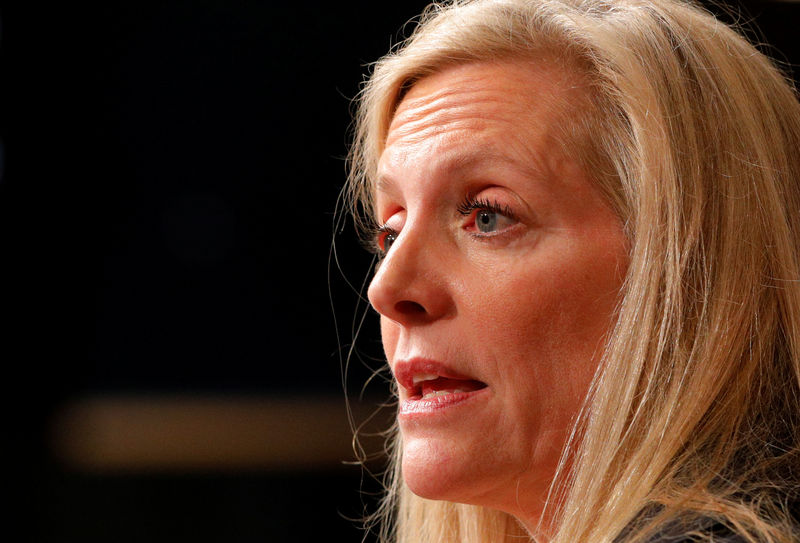By Howard Schneider
NEW YORK (Reuters) - The Federal Reserve should move from a strict 2% inflation target to a broad, "flexible" promise that inflation would average that level over time, a key member of the U.S. central bank's board of governors said on Tuesday in one of the most explicit endorsements yet of changes in its monetary policy framework.
Fed Governor Lael Brainard said her idea would see the central bank change its target, after sustained periods when inflation has been below 2%, to a similar level above 2%, and tell the public that inflation would run higher for about the same amount of time.
Her concept, she said during an appearance before the New York Association of Business Economics, is less strict than some of the other proposals being floated as part of the Fed's current review of monetary policy. But she feels it would be more credible in the eyes of the public as a result, and give Fed officials more leeway in deciding how to set interest rates at any given point.
Some of the other ideas under discussion may seem promising in theory. But they involve concepts that may be hard to communicate to the public, Brainard said, and would also more strictly limit the policy options of future central bankers - a "commitment" that households and investors may not believe will be fulfilled.
Even related ideas like "average inflation targeting" would be "quite precise about what the path of policy would need to be to achieve ... average inflation of 2% over a specified time," she said.
"The formality would be quite challenging to communicate ... It is a lot easier to say 'we have been in the range of 1.5 to 2 over the last few years ... we would expect to see inflation in the two-and-a-half range for a period of years' ... That is a fairly simply thing to communicate."
The review that is underway is due to be completed next year, and no decisions have been made.
However, Brainard's was the first explicit call from a member of the Fed's Washington-based board of governors for a particular change to the central bank's methods for managing inflation.
It also points to the general direction the Fed seems to be heading as it nears the end of the review process.
FED REVIEW
For several years, Fed officials have been laying the groundwork among households and investors to accept higher rates of inflation than have existed for the past several years. They now routinely note that their 2% percent goal is "symmetric" and not a ceiling, and part of the rationale for the ongoing review is to find ways to nudge sliding public expectations about inflation firmly back to the 2% level.
Brainard has said one current aim of policymakers is to put the public on notice that the Fed would not stand in the way of "opportunistic reflation."
Fed officials acknowledge that their failure to hit the 2% percent goal for seven years running is a key problem that poses a variety of risks, including leaving interest rates stuck at ultra-low levels, and raising the likelihood that interest rates and inflation may all slip back to zero. That would force the Fed to again use "unconventional" tactics like bond purchases to boost the economy in a downturn.
The review, launched earlier this year, was begun as a broad debate over ways to better insure the inflation target is hit and maintained.
In recent comments, however, Fed Vice Chair Richard Clarida, who is overseeing the review, has said the central bank's existing framework is adaptable enough to meet the central bank's inflation goals.
Other Fed policymakers have suggested the same, pointing to the review as likely producing an "evolution" in how the Fed speaks about and describes its inflation goals, rather than the "revolution" of introducing new strategies that have been written about and researched extensively by economists, but not yet tried out in practice.
The Fed is not always a swift innovator - the U.S. central bank waited roughly 20 years, as other central banks adopted specific inflation targets, before making that shift itself in 2012.
On Tuesday, Brainard also suggested that if interest rates ever hit zero again, rather than simply relying on bond purchases as it did in the last crisis to stimulate the economy, the Fed should pledge to cap Treasury bond rates at different levels and intervene in markets as necessary to maintain those rate ceilings.
